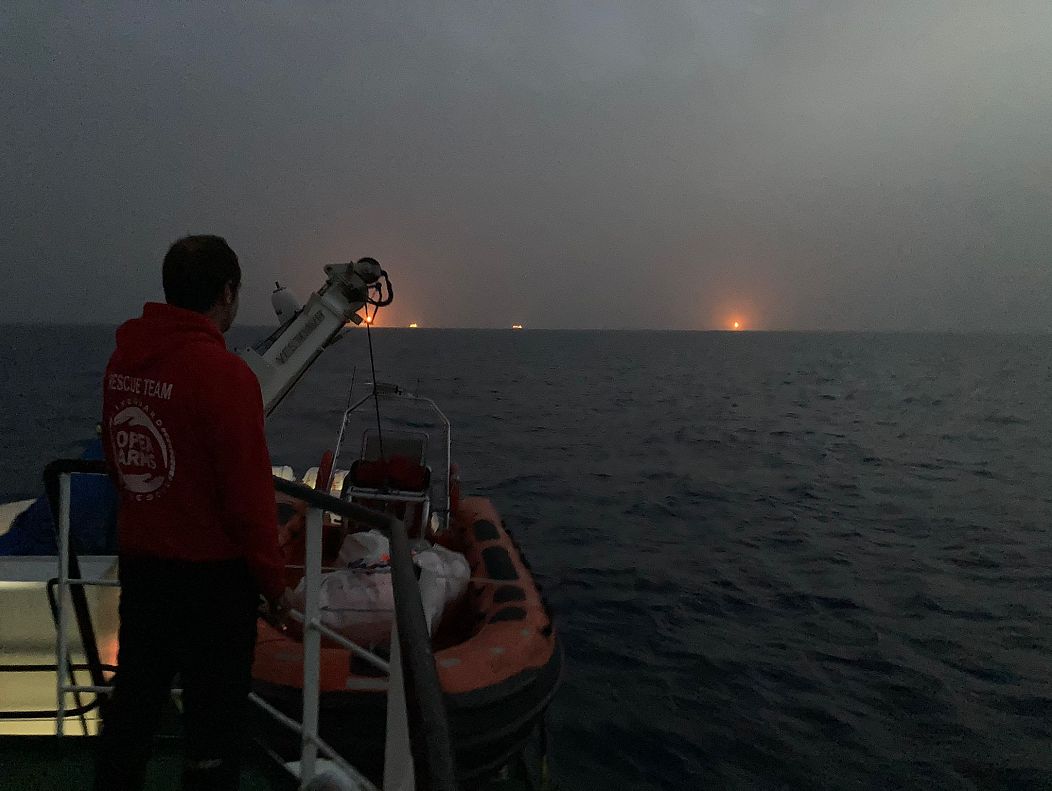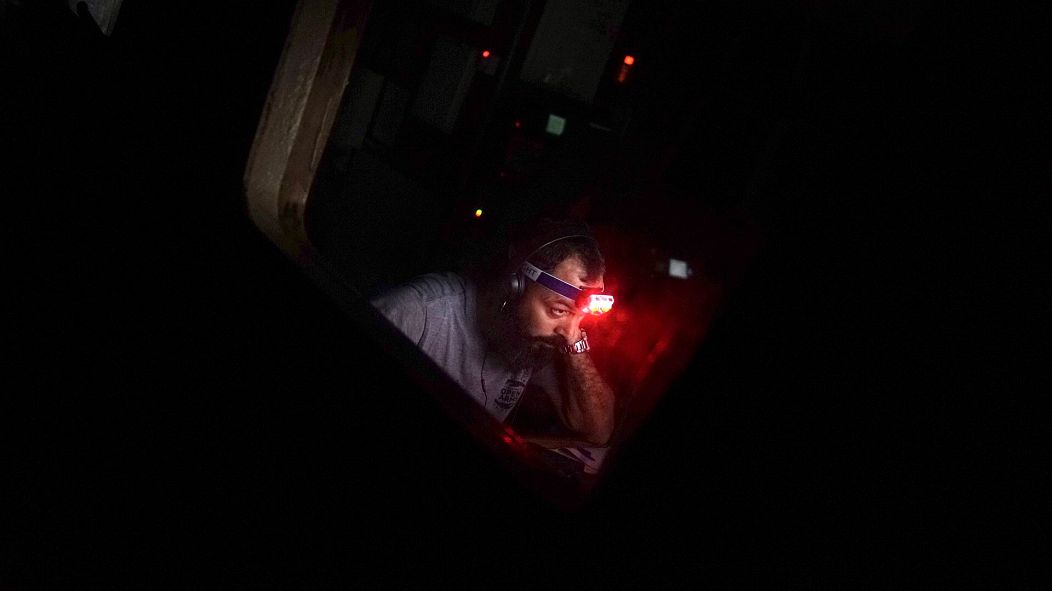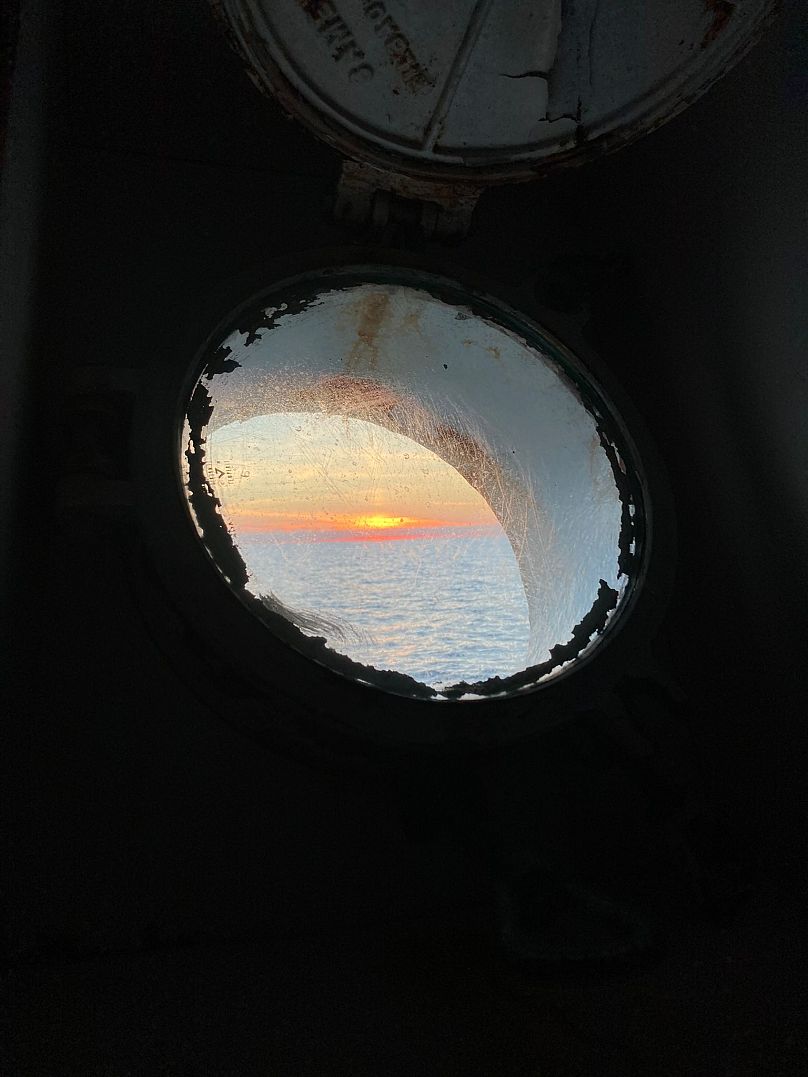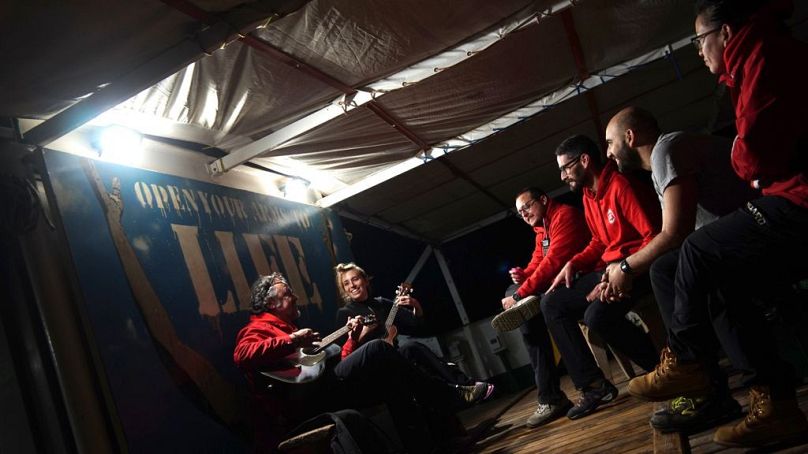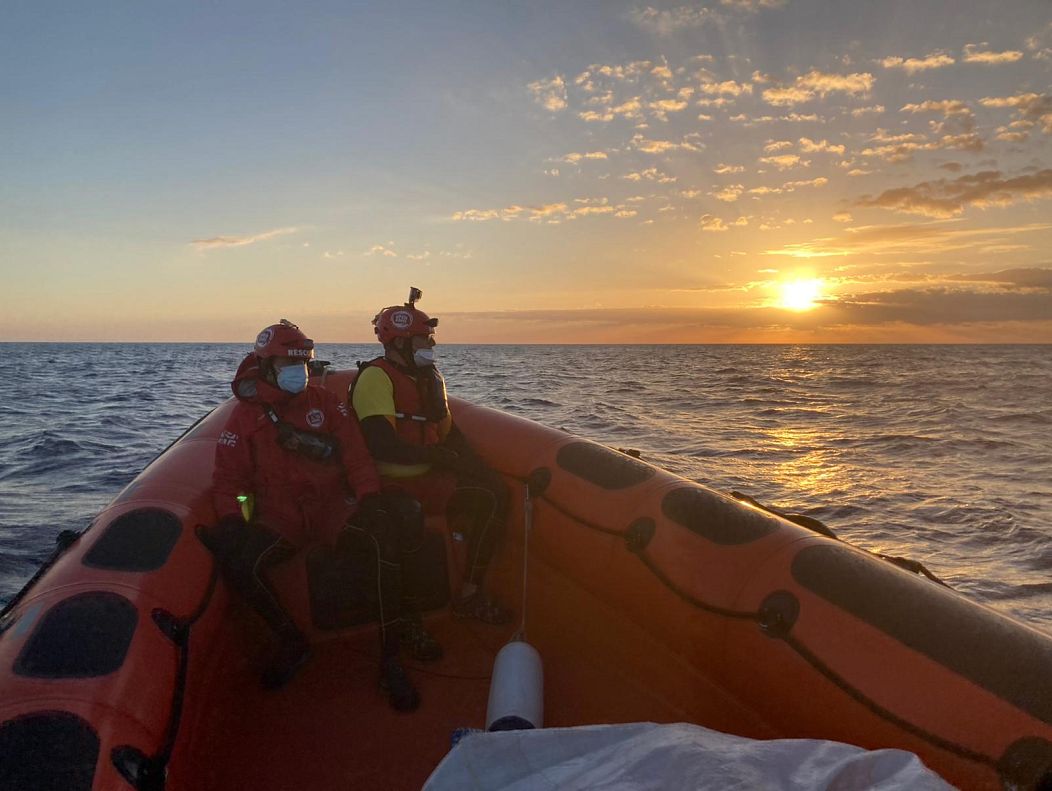Euronews' Pablo Ramiro joined NGO Open Arms on a migrant rescue mission in the Mediterranean Sea. Here's what he saw.
"In those oil rigs, the hell of Libya begins," said Marc Reig, the captain of Open Arms, as he looked out on the horizon to glimpse four monstrous structures; structures that sit some 80 nautical miles from the coast of Tripoli.
The image itself is terrifying: two pairs of metal skeletons protrude from the sea and spit fire into the air, illuminating an apocalyptic scene for anyone around.
This is also the place that - guided by the rigs' light - some migrants travelling from Libya believe they have reached Italian soil.
Nothing could be further from the truth. These rigs are Mellitah oil and gas extraction centres owned by the Libyan National Oil Company and Italian oil company ENI; the former wanting to revive its oil heyday from the Gaddafi era when 1.6 million barrels of crude were produced a day.
Reig's comment, meanwhile, which likened the rigs to the border of hell, has a double meaning. The first is geographical, while the second is rather symbolic.
Since 2011, two civil wars have plagued the country: the first erupted after the fall of long-time dictator Muammar Gaddafi; the second, which began in 2014, is still ongoing as armed militias vie for power. It has turned the oil-rich North African nation into unstable territory now led by factions that are out of control.
For this reason, Libyan ports are not safe places to be, as confirmed by the United Nations and the International Organisation for Migration (IOM).
Enjoying euronews.com? Try our app to get alerts for our best European stories and all the latest breaking news. It's available on Apple and Android devices.
Burning boats after migrant rescues
It's February 7, morning, and we've been sailing with Open Arms for five days when we spot a structure floating adrift: it's the charred hull of a boat.
The Libyan coast guard burns the boats of the migrants it rescues - a practice deemed fairly unorthodox as semi-sunken remains can cause problems for other vessels getting by.
The blackened structure before us now, floating along, paints a bleak landscape.
It's a calm day with hardly any waves. At noon, we receive an email notification from MoonBird, the NGO SeaWatch plane that locates drifting vessels in the Mediterranean and sends coordinates to national authorities and fellow aid organisations.
This time, the coordinates are for a boat in a bad condition about 50 miles (80 kilometres) off the Libyan coast.
Open Arms sets off immediately for the indicated position, without knowing whether Libya's coast guard has already arrived - or intends to do so. The communication channel is the same (16 on the radio), but the coast guard rarely reports its activity. In fact, it hasn't done so at any time during this mission - and the Open Arms crew assure us that this is the general trend.
If the Libyans decide to answer the rescue call, they will surely arrive before us. Their ships, many ceded from Italy, can sail at more than 20 knots. Open Arms, meanwhile, reaches just eight.
Coordinated, trained and funded by the European Union, the Libyan coast guard rescues migrants from the Mediterranean and returns them back to base - precisely the destination from where many were fleeing in the first place. Some will even jump off Libyan ships if they see an NGO rescue vessel nearby.
The IOM frequently denounces these returns, considering Libya an unsafe port.
For Open Arms, the strategy to buy time and beat the Libyan coast guard to the rescue is to lighten the pace with its two smaller vessels. The crew will deploy "Fer" and "Echo 1", which are semi-rigid boats each with 115-horsepower engines and can be lowered into the sea using two large cranes. All of this takes place without having to stop the ship.
This time around, however, there's no need for Fer and Echo 1 to hit the sea. MoonBird says the coast guard has already conducted a rescue, bringing everyone on board. They then set the abandoned vessel on fire.
Difficult decisions
Eight days later, a new notice arrives: the NGO AlarmPhone, a service in charge of registering and locating calls for help from the Mediterranean, has just sent a notification.
This time, a boat is adrift about 24 miles off the Libyan coast. Too close. That's a distance Open Arms won't approach.
Mediterranean NGOs always work within waters deemed inside the Maltese search and rescue (SAR) zone - and will only venture into Libya's SAR zone if they are the closest vessel.
The SAR convention divides seas and oceans into salvage zones. Each country is assigned one of these areas and is in charge of coordinating the rescue operations that take place within them. These divisions, however, are established over international waters and do not imply that the area belongs to the assigned country.
In this case, the boat is also extremely close to Libyan territorial waters, which start around 18 miles (29 km) from the coast.
From the Open Arms command bridge, the crew tries to contact the Libyan coast guard, which, after 20 calls in Arabic and English, only answers once - and just to ask for exact coordinates without reporting their intention. In any case, if their intentions were reported, the dodgy reception may have cut the vital details out.
Silence reigns on the command bridge.
The decision is difficult: approaching the few miles toward Libyan territorial waters means endangering the entire crew of the ship; however, failure to approach also risks the lives of dozens of people stranded on the damaged boat - especially if the Libyan coast guard decides against coming to the rescue.
Eventually, Open Arms sets sail to meet the boat - but there is nothing left at the specified coordinates. The crew later discovers on social media that there was a rescue effort that matches the advisory. The Libyan coast guard had beaten them to it.
It's February 10, the sea is calm, and the Open Arms crew has not carried out any rescues for more than a week. The weather forecast is unfavourable for the next few days.
This can mean three things: 1) small boats of migrants have already been rescued by the Libyan coast guard; or 2) no migrant boats have departed from Libya; or 3) boats have departed - but no one has found them.
This makes the staff inside the ship impatient: if there are no rescues in 15 days, they will have to return to Barcelona. The ups and downs begin to take their toll on the crew, who are digesting the idea that the mission might be coming to an end.
Libyan interference
It's February 12, morning (again), when Open Arms receives another new notice. This time, Colibri 2, the plane of the volunteer pilot NGO Pilotes Volontaires, has spotted a wooden boat with 40 people on board. It's 122 nautical miles off the Libyan coast, and it's inside the Maltese SAR zone.
Open Arms is just two hours away from the indicated coordinates, which means it's time to lower Fer and Echo 1. A very complex journey is ahead.
A few miles in, Echo 1 loses an engine and is forced to downshift: it will have to act as a radio communication link between the mother ship and Fer. And the difficulties do not end here.
"Fer to Echo 1, the Libyan patrol boat has come to our starboard crossroads and is following us," Fer's skipper Albert Roma is heard saying across the radio.
It appears a Libyan coast guard vessel is interfering with the rescue operation, eventually forcing the rescuers to stop.
Again from the radio: "Open Arms - from Fer, we approached the patrol boat on their orders."
The image is threatening: the Fezzan 658, a frigate ceded by Italy to the Libyan coast guard, crosses the path of the rescuers.
"You know this is Libyan waters," a man shouts in broken English from the boat. But this isn't true - the operation is 122 miles from Libya's coast and is under the jurisdiction of Malta.
Minutes later, the Libyan frigate moves away from Fer, but continues another few minutes of persecution before finally giving up and setting off to Echo 1.
There, they repeat their operation: approach and threaten; and, eventually, give up.
Such disagreements have been a general trend on this mission.
Emotional rescue
Later in the evening, around 8 pm, forty migrants are evacuated from their vessel, which is just over 12 metres long. It's surprising how far these small boats are able to travel when they are equipped with little more than an old GPS and several fuel canisters.
Among those climbing aboard the rescue ship is Ludovic Ndomkeu. His face is round and smiling; although, he doesn't smile openly until the end of this story (like many others rescued alongside him) when he finally sees the Italian coast.
Ludovic is just 15 years old and has been travelling for six months. He has no shoes; no luggage beyond his mobile phone.
The teenager tells us that he fled his native country Cameroon after he was subject to violence due to, he says, his "orientation". He refuses to say any more as he still isn't sure of whom he can trust.
Stepping on to Open Arms, however, Ludovic cannot hold back his tears. He approaches the crew and asks: "Spanish?" Those present praise his pronunciation as he continues with a few more words.
Ludovic's dreams are austere; his illusions painfully realistic: he says he wants to work in a "call centre" to receive and make calls. That is why he has dedicated himself to teaching himself new languages. Thanks to a free internet text translator, Ludovic speaks German and understands Spanish and English as well.
Among the other near-40 people who were also rescued and brought aboard Open Arms, the atmosphere is tinged with celebration - but this lasts just a few hours as there is hardly time to rest.
The following morning, Albert Mayordomo, the leader of the mission, approaches the lifeguards again: "Guys," he says. "We have another warning."
The latest boat is very far away - more than 70 miles (112km), in fact - and is almost eight hours of sailing away, judging by the average pace of Open Arms. To make matters worse, a storm is approaching the area that could complicate the operation further and could undermine the health of the 40 rescued migrants who have now been at sea for more than 24 hours.
Despite this, Open Arms sets out for the rescue - as, after all, if the Libyan coast guard nor the Maltese authorities respond, the lives of the 100 migrants on board will likely be lost.
By sunset on February 13, Fer and Echo 1 were back on the water to establish visual contact with the stranded vessel.
Choppy waters
Straddling floats, legs dangling over the side of the boat as their feet disappear beneath waves whipped up by a worsening storm, some 106 people are crammed into a giant inflatable boat.
Halfway through the rescue operation, the Libyan coast guard reappears. The frigate radios Open Arms accusing it of operating in Libyan waters - but the rescue crew push back, saying it is actually 11 miles within Malta's SAR zone.
The Libyan coast guard is just watching. Meanwhile, as the operation continues with just one of the two boats, a single-engine and an increasingly rough sea, the situation gets complicated.
Waves of up to four metres make it difficult to transport people to the mothership as getting them on board requires intricate precision.
In a stroke, one of the two rescue boats fills with water when only a five-year-old girl and her mother are left to climb. But skipper Albert Roma manages to manoeuvre in time to avoid a tragedy.
It takes around 24 hours for Italian authorities to assign Open Arms a port to disembark. And, although the joy on board is palpable, there are still three long days of sailing ahead with unfavourable weather conditions, which make the journey especially hard.
There are also more four-metre waves and low temperatures to tackle, along with an influx of water from all four sides of the boat. Life on deck is uncomfortable; vomiting and dizziness, constant.
"Water, please - what language do you speak, Spanish?!" says Maurice Echambi, a 40-year-old Cameroonian, who begins listing the languages he speaks so he can communicate with one of the volunteers on deck.
Maurice is sitting on the wooden floor and is covered with a blanket and is wearing thin, blue hospital scrubs that he changed into when he ditched his wet clothes. The volunteer is dressed in personal protective equipment (PPE) to barricade against potential COVID-19.
"In my country, there are many problems," Maurice tells us before disembarking. "There is a war between two regions and we have lost many things there. That's why I came to find a life, to see if I can get a job and help my child, my family, my mother."
As Open Arms eventually docks in Empedocle, Sicily, the celebration is tinged by the shadow of the ongoing pandemic.
"The good news is that the 146 people rescued have tested negative [...] For our part, and despite the fact that no member of the crew has tested negative, the Italian authorities have forced us to quarantine for two weeks without being able to enter or leave the ship," says Juanfe Jiménez, an NGO doctor.
It is the Italian Red Cross that conducts COVID tests on all the rescued migrants - and while none tested positive, isolation is still mandatory.
Many of the ship's passengers, barefoot and covering their feet with plastic bags, descend one-by-one onto the plank to disembark into the Italian port. Their stay on land will be short - a bus will take them to another ship anchored four miles from the Italian coast, where they will wait for the beginning of a new life: this time not away from the Mediterranean but from the pandemic.












